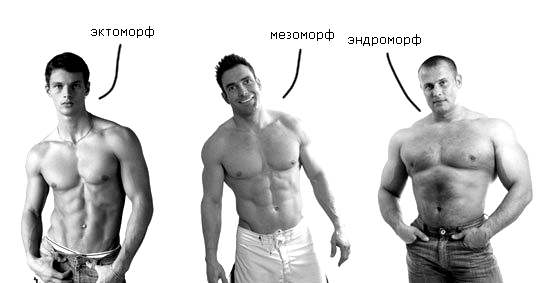I am Ectomorph or Panoli
There is a time when the average gym user knows about the existence of the so-called somatotype. Then he starts saying things like “I am ectomorphic so I don’t grow” or “I am endomorphic in my legs and mesomorphic in my chest” or similar nonsense. This is all equivalent to “I have a deltoid muscle full of red fibers because I can do 10 reps and recover well.”
This is one of those situations in which complex concepts are processed without understanding them, and authentic urban legends are generated. Sorry to sound like a typical know-it-all, but I don’t like certain depersonalizing classifications.
I did a search and this is what I figured out.
SOMATOTYPO NESOMPRESSION
In this pseudo-article, I first want to describe what a somatotype is and why it was invented, explain why it is wrong for me to set reference models and why, in my opinion, the somatotype has significant limitations. Finally, I’m going to talk a little about the classic hardgainer.
A person, in order to understand things well, must simplify complex phenomena: with his help he can somehow dominate them. Thus, over the centuries (centuries!), Attempts have been made, theories, suggestions and ways have been invented to classify people.
An example of a classification is the scale of the distribution of people by body mass index or BMI (weight divided by the square of height in meters):
- 18.5-25 – normal weight
- 25-30 – overweight
- 30-40 – obesity
- 40 – severe obesity
Huge human variability reduced to 5 grades. The advantage of this scale soon becomes apparent: a person’s health status can be determined quickly and non-invasively. Statistics show that increased BMI correlates with increased cardiovascular risk, obesity, high cholesterol … and everything we know.
I reduce the complexity in a way that can handle this. Without BMI, it would be necessary, I don’t know … to have blood tests done for each individual subject; that is, a method that is more individualized, but more expensive and more invasive. However, we noticed that even so it starts with acceptability of test values: all men are “equal” if they are within the acceptable range of blood values.
It is also important to note that all simplifications have limitations in the sense that the more the subject deviates from the reference statistics, the less it will be possible to make the correct classification. BMI fails miserably for very muscular and low fat people. For example, I weighed 84.5 kg, 175 cm in height, my BMI is 27.6, which is an indicator that classifies me as overweight, when in fact it is not. On the other hand, if I use BSI, things might be different … It doesn’t make sense for me to implement the same strategy as an overweight person. BMI is incorrect, but my analysis is not.
Knowledge of the boundaries of the classification system is mandatory. Therefore, when you hear the word “somatotype”, you must consider what we are talking about and, of course, its limitations.
(Now I am beginning to enter a land almost unknown to me, so whoever is a specialist, have mercy, and who is not, do not think that I am an expert in embryology)
In 1940, the American psychiatrist Sheldon introduced a classification of people based on the assumption that each person has three components that are directly related to how they developed in the embryonic phase. In fact, embryonic cells, when they begin to differentiate, are divided into three “layers”: endoderm, where all internal organs, internal organs, and visceral fat come from. endoderm characterizes the endomorphic component (endomorphism) of a person, his ability to gain or lose fat). mesoderm, where the musculoskeletal system originates; This characterizes the mesomorphic component (mesomorphism) of a person, his ability to gain or lose muscle). ectoderm, from which the skin, nervous system, blood vessels come out; This characterizes the ectomorphic component (ectomorphism) of the individual, that is, his “thinness”.
Sheldon introduced a scale of 1 to 7 for each component, always in ecto-meso-endo order. Thus, each person is characterized by three numbers that determine what is called a somatotype, a quantitative assessment of the shape and composition of the current body.
The studies were conducted on a sample of 4,000 male students, and later (in 1954) the Atlas of Man was published with an analysis of 46,000 men aged 18 to 64, from all social classes. This should give an idea of the scale of the work.

The main idea was to find out the relationship between these three numbers and accurately determine the somatotype, psychological and physical characteristics. I banalize them all with a synthetic mirror:
- Endomorph: plump, cheerful, lazy, cheerful, sociable, easily conveying emotions.
- Mesomorph: slightly introspective, action-oriented, decisive, energetic, dynamic.
- Ectomorph: cerebral, introverted, nervous, shy.
It seems obvious that while this classification can work in many cases, it will not work in many others. But we do not have the knowledge to fully understand this approach, and we only get to what is read here and there. Therefore, please do not make value judgments, but focus on the goal: it would be very interesting to be able to associate certain physical traits with psychological, with diseases, with deviations, with diseases.
Therefore, there are people who study all this, statistics and everything else. It is also clear that it is highly likely that an endomorph may have a high BMI, so it is statistically significant that an endomorph may have an increased cardiovascular risk due to increased fat.
Sheldon was a psychiatrist and was looking for a way to correlate the somatotype, the expression of the physical body and the temperament of different people. These theories have today been rejected and replaced. For example, one of the conclusions of some theories based on Sheldon’s idea was that mesomorphs were more prone to criminal relationships. All this was then very well suited for small conversations about race and the superiority of one over the other. In the end, the critical movement against him was impressive, and 4000 photographs used for the first analysis were destroyed.
There are studies to determine the somatotype of athletes from various disciplines (including bodybuilding), others to link somatotype to various diseases, and others to understand how the somatotype develops as adolescents grow. I found research that looks at the somatotype of people with Down syndrome. Important are studies that correlate the somatotype with the well-being of different peoples, that is, with changes in the body depending on the socio-economic situation.
While the psychological part of this approach has been eliminated, the one related to body composition is thriving even though we have a lot of data and measurements.
Therefore, in the world of sports, the somatotype matters. In simple terms, we can say that the more mesomorphic, the more skills you will have in sports, since the skeletal and muscle structure achieves better development. The more ectomorphic it is, the less development there will be, since the structure is thin and does not support large workloads well. Likewise for those who are endomorphic, given the increase in body fat rather than muscle.
It is clear that no one is “pure” in their type, so an endomesomorph or mesoendomorph will still be suitable for sports, since they will not accumulate fat and will have more muscle. Now comes the typical simplification in the gym: the ectomorph is the least fortunate of the group.
If we continue to simplify, note that there are diagrams that explain, for each of the three types, what would be the most appropriate training, including the number of runs and optimal repetitions for each somatotype. I disagree with this approach, I think it is a simplified way of solving a complex problem: we have to go into details on how to calculate the somatotype.
HOW TO CALCULATE SOMATOTYPE
Unlike some learning theories defended for years, the scientific world subjects its knowledge to constant analysis: one of the many criticisms of Sheldon’s method was the methodology used to achieve somatotype coefficients: the use of photography of objects in standard positions. Thus, in 1967, two other scientists, Heath and Carter, defined an objective, measurable, and reproducible protocol for somatotype determination. Here we went: I want to describe why my proposal
The following quantities must be adequately measured:
- Object height
- Weight
- Triceps Curl
- Sublagular fold
- Supraspinal fold
- Double folds
- Definition of mesomorphism
- Right humerus diameter
- Left thigh diameter
- Right hand circumference
- Right Calf Circumference
Endomorphism coefficient is determined for body folds, which are indicators related to body fat.
With the lengths and circumferences of the limbs, which are measures related to muscle and skeletal mass, the mesomorphism coefficient is determined (fold values are subtracted to have the relative values of muscle and bone to the fat grid).
With height and weight (measures associated with “thinness”), the coefficient of ectomorphism is determined.
The method is absolutely precise and standardized, and each measurement is fully described in the methods and tools that will be used. The calculation is based on formulas obtained from statistics, which, in turn, are determined by codified research. The official guide for the creation of this game is 25 pages and is a key document in the international scientific community. Therefore, the definition of somatotype is a “scientific” protocol, not only in the usual sense, but also in the correct meaning of the word.
After you have determined your somatotype, you can place 3 numbers on a Cartesian diagram. 3 numbers are related to the coordinates of a point in space, but 3D graphics don’t like them because they don’t work well on paper; so a transform (which I’ll save you) is used to build a 2D view and thus get a very nice and readable graph. Let me remind you that if you find a PT that uses big absurd words and crossed out this graph, you should ask him what is depicted on the different scales. If you don’t know … it just repeats like a parrot.
Strong, right? This graph contains 3 numbers, the closer we are to the apex of the inflated triangle and the more pronounced one of the symbols. Bottom left, thick, and bottom right, delegates; and in the upper central part – muscle.
If you look at small numbers, there is a connection between them, in the sense that the more ectomorphs you have, the fewer endomorphs and mesomorphs there will be, although they can be very mesomorphic and very endomorphic at the same time. In practice, it is impossible to be both very delegated and at the same time very fat (of course), but also very slender and muscular (ectomorphia is associated with the ratio between height and cube root of weight); therefore, someone who is lean / dry weighs little in relation to height.
On the contrary, you can be very muscular and very fat; in fact, there are numbers outside the reference triangle.
The coefficients start at 1 because Sheldon stated that it is impossible for a person to have a complete absence of a component (since they are obtained from embryo stratification and there are always all 3 layers).
The base scale of each coefficient is as follows:
- 1-2.5 – low
- 3-5 – moderate
- 5.5-7 – high
Values 7 and value 0.5 are also available
The central point, which corresponds to 4-4-4 and 3-3-3, represents the complete balance of components and is called phantom, since it is almost impossible for a person to imagine such a somatotype. The standard categories are 12 if the phantom is excluded and has names such as mesomorphic-endomorphic, balanced ectomorphic, ectomorphic-mesomorphic, etc. They are associated with the mutual influence of various components.
So far we have described the method. To fully appreciate and “master” it, we must know its limits. Let’s just say: a somatotype is a tool, a tool, as Charles Staley would say.
I like to use the saw comparison, which is good at conjuring up images of horror. Even a chainsaw is a tool with huge advantages for sawing branches, for making firewood. I don’t think anyone has used this to cut up fried chicken or grate cheese. Each tool has a specific application. Using it for inappropriate use can be absolutely disastrous.
The first consideration to be made without going into details is this:
YOU, have you made such a measure? Because if you haven’t done that, saying “I …” is absolutely pointless. This, you must put it in your head: you are making hypotheses; But since you don’t have a precise quantification, what considerations can you make? Maybe you’re right or wrong.
Therefore, to say “I am mesomorphic in recovery and ectomorphic in increasing muscle mass” is equivalent to “I think I am 190 cm” when you are only 168 years old, or “Angelina Jolie loves me” at age 80. You have 3 phone numbers on your mobile, and only one number belongs to a woman: your mother.
Be careful: you use words without mastering the meaning. Therefore, you can use “thin” and “thick” instead of the more bombastic “ectomorphic” and “endomorphic”. I invite you to reflect on this question.
REAL EXAMPLES
The second consideration is that gym goers have completely wrong links. Even many sites have examples of somatotypes taken from bodybuilding. Like … “Yeats was endomesomorphic and Levrone was pure mesomorph” (I swear I saw …).
This is nonsense. Professional bodybuilders, to use Marvell’s term, are absolutely meta-human. A person who is in competition – HP + 25-3% fat is unnatural. These are not moralistic speeches about doping, but simple observations. These are completely mesomorphic people with blue eyes, 1-7-1 and above.
Therefore, you should debug these reference models. I suggest you are much more reliable. You can find them on the FIDAL site, people who practice athletics. 
In the photo there is an ecto-mesomorph or meso-ectomorph, well … he is, of course, skinny skinny. Andrea Bettinelli, jumping 2 meters and 30 centimeters. It measures 194 cm and weighs 82 kg. This is HP-12. Guys … if he posted his measurements on the forum, he would be considered professional small.
I’ve never seen such an athlete up close, but I’ve met people with 2.15 and 2.20, and I can make a comparison.

As a pure mesomorph, I chose Francesco Scuderi, who makes 100 meters in 10 “19. It measures 168 cm and weighs 68 kg, with HP + 0. Again, this would be absolutely normal for us, but only because Coleman and the rest of the media come to mind. HP + 0 with Right Fat is a goal for minimum gym mass.
If you believe what you read about mesomorphs, this level cannot be 100 meters. Fast fibers, explosiveness, dynamism, adrenaline.

As an endomesomorph (certainly more mesomorphic than endo) I chose Paolo Dal Solio, 21 meters and 3 centimeters in shot put, 190 cm tall and 125 kg in weight. , HP + 35. Whoops! HP + 35, but if you look at the image, it is not as unreal as Hoole: it is super massive, but covered with a lot of body fat, as is usually the case with such a person.
As you can see, here are some patterns to follow, not those seen in Flex, Musclemag, etc. Please, I ask you to think that bodybuilding magazines are capable of distorting reality by throwing out the wrong messages , such as the fashion world, with models weighing 25 kg.
Yes, it’s okay: this is a game, but there is research on relevant samples that covers the topic well. At this stage, you can say the following: “Bodybuilders are mesomorphic”, “Marathon runners are ectomorphic”, “Powerlifters are endomesomorphic”. Fair enough. True. But at this moment there is a logical and dangerous leap in all this: “To be a bodybuilder, I must be a mesomorph”; or worse, we are interested in: “I am ectomorphic: I will never be a bodybuilder.”
I repeat: the conclusion suggests itself: “I am ectomorphic: I will never be a bodybuilder”, which, in the words of Macroberts, “is a person with a hardgainer.” Keep in mind that this is the essence of everything.
But what actually holds the somatotype? Does it make sense to me that I go to the gym as an amateur? Or am I looking at things that are irrelevant, putting myself in a corner to get hit and that’s it?
Let’s take a look at the true great somatotype limit. Sheldon bases his theory on the fact that the somatotype is morpho-phenotypic. Easy, right? Read the word 3000 more times and say it in the pizzeria and you will make a great impression.
Short explanation: we inherited characteristics from our parents through genes. The genetic heritage is called genotype. What genes create is called a phenotype. In other words, the genes say that you are going to reach 180 cm: your height at 180 cm is the phenotype of his genetic inheritance, the manifestation of genes. Therefore, Sheldon argues that the somatotype was something unchanged, because it was a manifestation of human genes. This was necessary to correlate the somatotype with psychiatric profiles. Instead, although there is an obvious genetic basis, the somatotype changes over time.
If you gain or lose weight, you move from endomorph to ectomorph and vice versa; if you weigh and diet, and then become sedentary and sit in a chair and watch TV, you will go from mesomorph to endomorph and so on. In adolescence, the somatotype changes dramatically.
To avoid this problem, you need to think about what is truly invariable in the body. I know …: the width of the clavicle, the length of the hips, the profile of the muscle fibers, the hormonal system and so on. The problem is that there is no research in this regard; therefore, we must “be content” with a pure and simple somatotype.
In other words, only muscle shapes could be found in the 1940s; Today’s Sheldon invented the somatotype based on other variables, according to modern knowledge. Perhaps enter the amount of free testosterone or the level of thyroid hormones. However, they would have a better definition of genetic potential.
PHENOTYPE
There is an interesting phenotype characteristic: it is influenced by the environment. A phenotype is basically a realized genetic potential. For this to happen, an environment is needed in which it can manifest itself with appropriate stimuli. If the genes say that you have the potential to reach 180 cm, but you are malnourished, you will always be tall, but perhaps 175 cm.
So, referring to what we talked about earlier. It is clear that the 100-meter is mesomorphic; but he did it by unleashing his potential. Nobody chose him because he was mesomorphic, maybe he didn’t even seem like a child.
Now we are faced with the problem of who goes to the gym. In bodybuilding there is no choice, anyone can do it at any age and whoever they are. In its immense strength, but also in its greatest weakness, due to the lack of a control measure, it results in the absence of any choice.
In the gym, if you get something, you automatically become an expert in it. Maybe you got 3 on a scale of 0 to 100; but the fact of achieving something also makes you think in the way that something means. Thus, theories and myths are born. On the track … no. If you upgrade from 11 “8 – 11” 6 to 100 meters, you’re still slow, period. If in the gym you lift from 95 kg to 100 kg on the bench press, you feel like you have the right to confirm that your training method works.
Let’s take a subtle classic that never did anything, the yellow dot in the graph above. Its somatotype is purely ectomorphic, but since it is a “unique” image of the body shape, no one in principle can know what will happen to this type, what potential it will have, what is written in its genome.
For example, you can gain weight by increasing endomorphism, lose weight and increase muscle mass, gain weight and continue to increase muscle mass (red route), or you can increase your muscle mass slightly, but not much, while staying mostly lean (blue route).
Knowing only the somatotype does not allow us to establish the potential of a given individual, but only the environment and the stimuli that he will receive will determine what the potential is. Because it is the somatotype that is the phenotype, the manifestation of genes.
That’s why I’m stumped when I hear things like “I’m a Hardgainer”: at 16, I was thin, I trained to death; Then I found … (put what you want), and now, at 23, I weigh 90 kg. ” At the age of 16, you grow, your somatotype will change. Is it thanks to you if you weigh 90 kg now or would he arrive the same?
Let’s take a subtle classic that never did anything, the yellow dot in the graph above. Its somatotype is purely ectomorphic, but since it is a “unique” image of the body shape, no one in principle can know what will happen to this type, what potential it will have, what is written in its genome.
For example, you can gain weight by increasing endomorphism, lose weight and increase muscle mass, gain weight and continue to increase muscle mass (red route), or you can increase your muscle mass slightly, but not much, while staying mostly lean (blue route).
Knowing only the somatotype does not allow us to establish the potential of a given individual, but only the environment and the stimuli that he will receive will allow him to determine what the potential is. Because it is the somatotype that is the phenotype, the manifestation of genes.
That’s why I’m puzzled when I hear things like “Me: at 16 I was slim, I trained to death; Then I found … (put what you want), and now, at 23, I weigh 90 kg. ” At the age of 16, you grow, your somatotype will change. Is it thanks to you if you weigh 90 kg now, or has he just arrived the same way?
Ectomorph. You can stay that way, or at least be a little more “muscular” (blue route) or lose a lot of weight and then get muscular (green route).
How many times have you seen or heard of similar stories about this fat man (possibly in his youth) who then loses weight for the beast, and then eventually gains weight and becomes muscular? Have you noticed, among other things, that a man who was fat and slender had the same attitude of women to weight? Fear of weighing more, even if these are muscles that push from below and positively change the figure.
Thus, the environment affects the fatty somatotype, since the environment can determine the appearance of certain characteristics, if they are present. In practice, some of them are fat and cannot lose weight because leptin does not work well, they have hypothyroidism or whatever you want, or who get fat because they eat at McDonald’s and hide Nutella bread behind a sheet that says’ metabolic syndrome “. “.
These two examples should make it clear that a somatotype is only ONE component that describes you. This is related to your potential, but it is certainly not a complete idea. As already mentioned, a different somatotype calculation would be better.
Lots of people approaching the world of gyms are moving in an environment (albeit large) of a ghost: a little fat or a little delegated. Obviously there are exceptions, and everyone knows a friend’s cousin who has a strong uncle, right?
However, since there is no choice of types of aspiring physicists in the gym, they are virtually undifferentiated at the bottom of the diagram. Only reasonable time and training will allow these people to show their potential, and then their somatotype will be completely etched away. But only then.
Doing calculations two hours after you put your legs up in the gym is as silly as trying the max squat. Do you think it makes sense to do the maximum squat at the beginning of the “race”?
You must establish with great certainty whether you are a proponent or less. Some people: sorry, but it is. These people cannot strive to get what they would like. Look at the phrase: what would they like. In general, dissatisfaction is related to the distance that exists between the goal you have set for yourself and your current situation.
Some of them are delegates and they don’t care, so they are calm. Some of them are delegates, but they are not calm, because they would like to have another physicist. Well, in these cases guys, it’s fair to fight for improvement, but we need the peace of mind given by internal analysis.
CONCLUSIONS
I’m launching some concept worth speculating on. You cannot give a precise definition, or advise an analysis or anything else. Maybe it will work, but I think in the end there are likely indirect methods. For me, for someone who will be a hard gainer:

Must be between 22 and 24 years old. Musculoskeletal development must be complete, hormonal balance must be stable. It is useless for a 17-year-old boy to talk about how he performed miracles.
You must have regular training for at least two years. I mean a person who has tried a little bit of everything, maybe made mistakes or obviously illogical things, but gave it all constantly, 2-4 times a week. Two years are necessary for the cyclical nature of certain biological rhythms. Overall, in the second year, a clear improvement is also achieved by repeating the same workouts. If you train once a month or two months every day, and then two zero months, this is not part of the game.
The results achieved in terms of strength are “poor”. Maximum strength is something easily measurable. The average person at two years old weighs 80 to 90 kg bench press. Equivalent to 110-120 squats and 150-160 deadlifts. So … let’s say 40 kg of biceps with a barbell, 50 kg of military press, 10-12 pull-ups. Uh … I’m making up believable numbers. Although there are people who have a hard time gaining muscle mass, a hardgainer is defined by a lack of exercise, besides being thin or fat.
Who is not gifted in this state. End of the game. You will never lift 250kg of deadlift. After all, I’ll never understand Paul Newman’s icy stare at The Bully, even if I put on blue glasses and take a course to learn how to smoke like him.
We return to dissatisfaction: there are not gifted people who literally sell their souls to the devil in order to get something. “Oh, but you’re exaggerating …” Maybe, but when I read “Lifting 110kg bench press” or “I beat that big guy in the gym who always teased me,” I confirm that these people exist.
What are these people supposed to do? Simple and cruel at the same time: accept their condition and do not fight against non-existent opponents. Dear guys, the world doesn’t care about you and your bad genetics. Because “muscular” you do not exist, this is not what I think of you every minute for sure … It is you who always think the same thing while our friend thinks about the bills he has to pay.
Calm! Accepting our own limits involves recognizing ourselves and is the first step in overcoming them.


